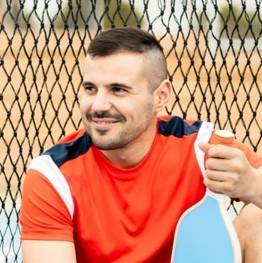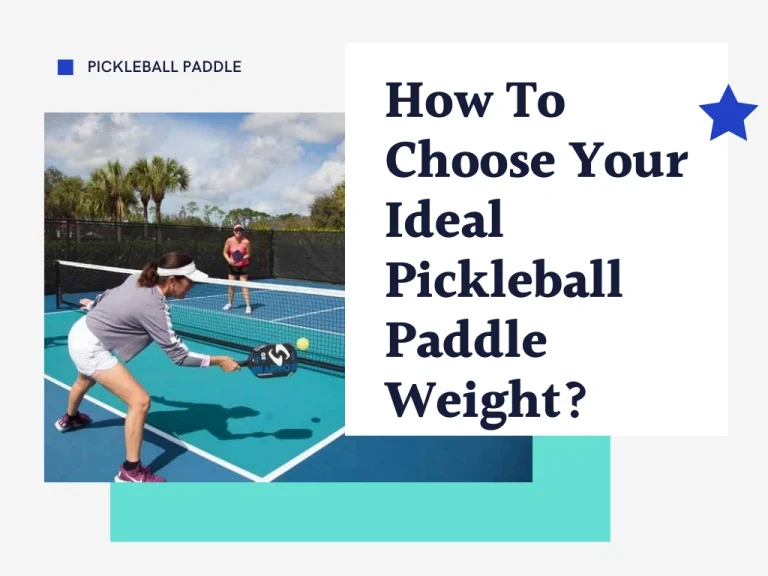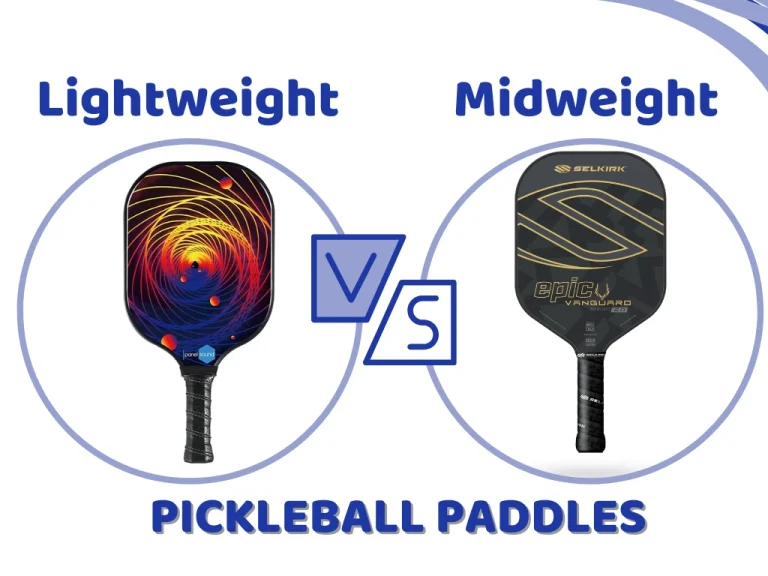Picking the proper paddle might be essential to improving your pickleball game. Choosing between a heavyweight vs. lightweight pickleball paddle is a crucial choice.
Every variety has unique benefits and accommodates various playing techniques. Information about their differences will help you improve your pickleball skills.
Pickleball paddles are classified as lightweight, midweight, or heavyweight depending on weight of paddle. This article will research & analysis the main distinctions between heavyweight and lightweight paddles based on publish data from brand, research and several years of experience playing with all types of pickleball paddle weights.
Key Takeaways
- Lightweight paddles promote movement and control while being comfortable on the arm. Paddles with more weight offer increased power, stability, and longevity.
- Heavier paddles tend to be more resilient and long-lasting than lighter ones.
- Choose a lightweight paddle if you focus on agility, quick reactions, and precise shot placement.
- Choose a heavyweight paddle if you desire forceful strokes, stability, and longevity during intense play.
Overview About Lightweight & Heavyweight
In the pickleball community, the weight of paddles is an issue of contention, involving player performance and comfort on the court. The standard range of paddle weights is 6 to 14 ounces, with variations in power, control, and maneuverability.
Lightweight pickleball paddles are popular among beginners, teenagers, and players with limited physical strength. As a result, lightweight paddles are used in training sessions and games to improve health and cooperation.
Meanwhile, heavyweight pickleball paddles are commonly utilized in professional competitions to maximize power and control in competitive encounters.
Amateur players can employ a larger range of racket weights, from light to heavy, based on their preferences and playing styles. In these leisure tournaments, the midweight paddle is the most popular due to its ability to combine power and control.
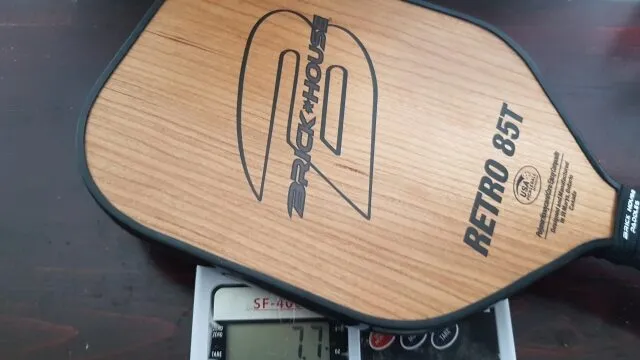
Comparison Table
| Key Note | Lightweight Paddles | Heavyweight Paddles |
|---|---|---|
| Materials | Polymer/composite core with graphite/fiberglass face. | Nomex/aluminum core with composite/graphite face. |
| Weight | 6.0 – 7.3 oz | 8.5 oz and above |
| Control | Higher control due to lighter weight. | Balanced control with more power. |
| Grip circumference | Thinner grip circumference for better control | Thicker grip circumference for comfort and stability. |
| Touch and feel on the ball | Softer touch, quicker reactions. | Solid feel, and more power on shots. |
| Durability | Moderate durability, weak impact-resistant | Higher durability, more impact-resistant |
| Price | It depends on the core and facial materials. | It depends on the core and facial materials. |
| Users | Beginners, players seeking agility | Advanced players, power hitters |
Lightweight Vs. Heavyweight: 5 Key Differences
#1. Durability
In general, heavier paddles tend to be stronger than lighter ones. Graphite and composites are not as durable as polymers, Nomex, and fiberglass because of their physical and structural properties. As a result, lightweight paddles tend to wear out faster with frequent play. Heavier paddles can bear greater strain and impact.
I had a lightweight paddle from a composite core and fiberglass face since 2021 – when I began playing pickleball. It is quite durable. I presented it to my son, and he was delighted. People tend to believe that lightweight materials are not long-lasting, but in my opinion, this relies on how they are maintained.
#2. Weight
Based on the parameters provided by the salesperson, you will know what type of paddle you have. With lighter weight (6 – 7.5 ounces), the paddle allows for improved maneuverability and faster reaction times. Heavy paddles (over 8 ounces) provide more power and stability but may cause exhaustion more quickly.
#3. Performance
Power and speed
With a heavier paddle, you may achieve more power and speed than a lighter paddle. Because in physical science, weight and force are two proportional quantities. As a result, the higher the weight of the paddles, the more force is generated.
Lighter paddles have less force but more speed, which makes them perfect for quick reactions and fast-paced games. Heavy paddles give strength to hits while keeping a reasonable speed. This makes them ideal for experienced players who require strong shots.
But as the weight of the paddle increases, the amount of strength necessary to hold it. Thus, the need for heavyweight paddle users is to have strong wrists and good endurance.
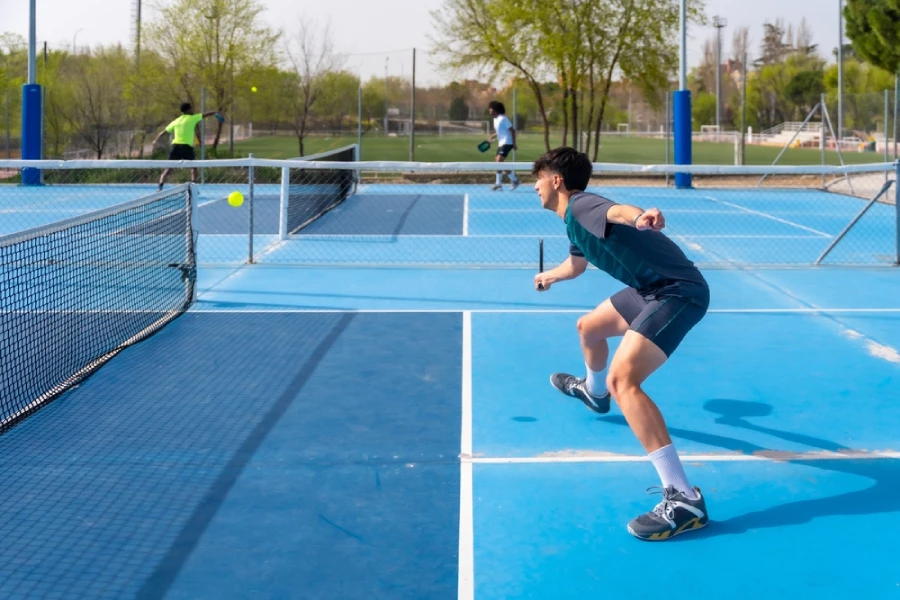
Control and accuracy
The lighter paddles will give you more control and accuracy than heavy paddles. When the paddle is less in weight, it requires less force to hold it. A lightweight pickleball paddle offers the least resistance to any paddle weight. This is perfect for putting shots exactly.
Heavier rackets offer fewer controls and greater power. The extra weight will improve the stability of both the serve and return, but it will limit your ability to control it.
Spin control ability
Lighter paddles control spin better than heavier paddles because people are easier to manage. The reason for this is that the paddle’s weight is lighter, so the earth’s gravitational force is less.
Heavy paddles give enough spin control while preserving strength. This will make them ideal for players who use a variety of spins during their gameplay.
Handle design and comfort
For those with small wrists, a lighter paddle will be more comfortable than a heavyweight paddle. Lightweight paddles include smaller grips that are easier to wield and kinder for players with smaller hands, causing less arm strain. Heavyweight paddles are designed with conventional or bigger grip sizes. They provide a stable and comfortable grip for various players, although they can become tiresome after extended use.
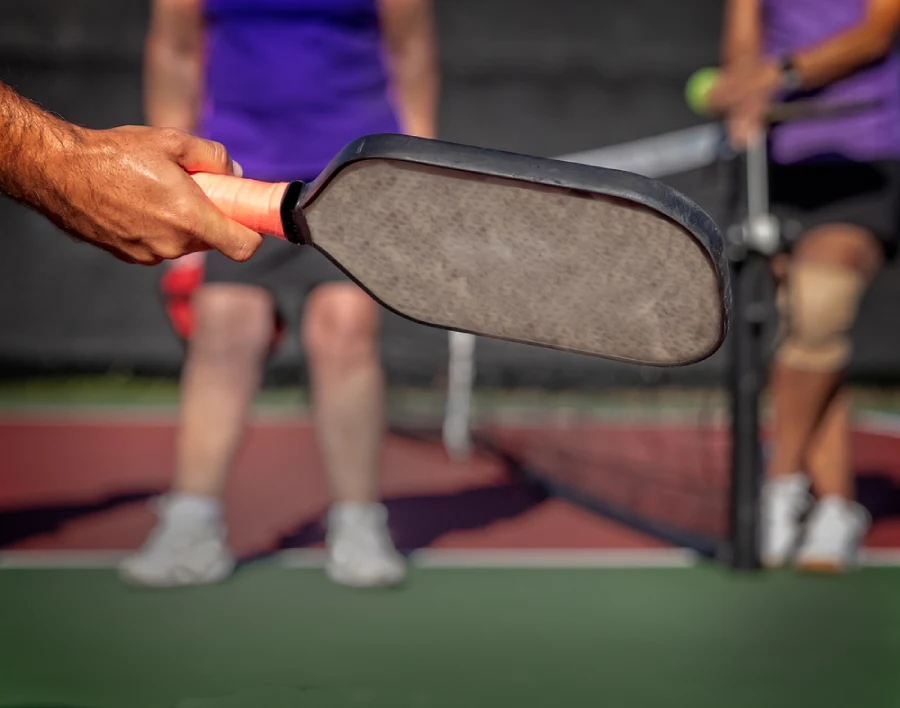
#4. Cost
Price-wise, a lightweight paddle will cost a bit more than a heavy paddle. After researching the average pricing based on the top list popular pickleball paddle brands, I discovered that prices for both types of paddles vary greatly, from several dozen to several hundred dollars, depending on the material and structure.
Lightweight paddles are more expensive, costing anywhere from $50 to $150 or more. The average cost of a heavyweight paddle is between $40 and $120, higher-end models may cost more.
The use of modern, high-quality materials like graphite and carbon fiber raises the manufacturing costs of lightweight paddles. These materials are selected based on their strength-to-weight ratio, which raises costs while improving performance.
Heavy-duty paddles are composed of Nomex, polymer, and fiberglass. Although these materials are strong and add to the paddle’s power and longevity, they are often less costly than the advanced materials found in lightweight paddles.
#5. Sound
A light paddle creates softer sounds than a heavy paddle. Light paddles are usually made of composite cores. This is a material with excellent impact absorption properties. So, a lightweight paddle often produces a quieter sound due to the lighter construction and materials that absorb more impact (around 60-70 decibels).
A heavyweight paddle tends to produce a louder, more solid sound when striking the ball, reflecting its heaviness and more robust build (around 70-80 decibels).
Lightweight & Heavyweight: Which Is Better?
Lightweight Pickleball Paddles
- Good maneuverability, simple to swing and maneuver, quick reactions.
- More precise ball placement due to better shot control.
- Reduces arm fatigue, during extended games or for players with low upper-body strength.
- Produces less power on strokes, so it’s more difficult to drive the ball strongly.
- Possibly less durable over time due to lighter materials.
- Could provide less stability when handling hard shots.
Heavyweight Pickleball Paddle
- More power and momentum, making it easier to drive the ball.
- Greater stability and solid feel, especially on hard hits and volleys.
- Often more durable due to the use of denser materials.
- Offers a more solid feel on impact, reducing vibrations.
- Less maneuverable, which can affect reaction time and shot precision.
- Can cause more fatigue and strain on the arm and shoulder during extended play.
- Price is generally more expensive due to the materials and construction.
Which Weight Should I Choose?
Choose a lightweight paddle if
- You are a newbie – It’s simple to control and manage with a lighter paddle. Perfect for players who are just starting and continue to develop their skills.
- You have arm or shoulder issues – The reduced weight reduces strain and fatigue, improving comfort for players with physical constraints.
- You are a defensive player – Lightweight paddles provide greater control and precision, allowing for accurate shot placement and finesse play.
- You play doubles – Quick exchanges at the net are common in doubles play, and a lightweight paddle helps with swift movements and rapid volleys.
- You are a female player: Many women prefer lighter paddles due to generally smaller hand skeletons and arm strength than men.
Choose a heavyweight paddle if
- You are an advanced player: Experienced players who can handle extra weight will enjoy the power and stability of a heavy paddle.
- You are a power hitter: The increased weight provides greater power in each shot, making it easier to drive the ball with force.
- You play singles: Extra power can be helpful in singles play, where controlling the game with strong shots is a key strategy.
- You seek durability: Heavyweight paddles, made from robust materials, tend to be more durable and can withstand frequent, intense play.
- You are a male player: Many men prefer midweight and heavyweight paddles due to larger hand skeletons and greater arm strength than women.
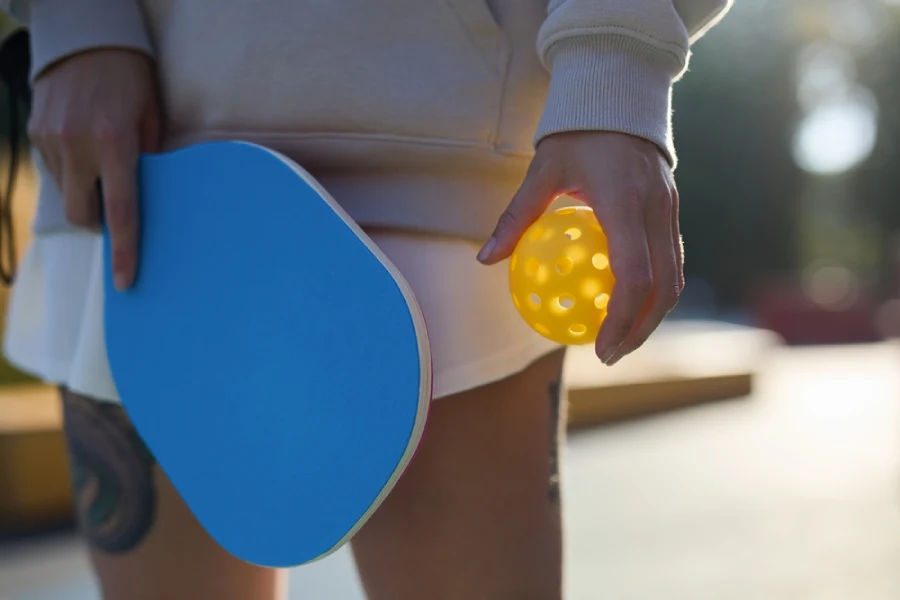
Final Though
When I first started playing pickleball as a newbie, I realized that using a lightweight paddle was best for me. The smaller weight made it easier to move and manage while I learned the basics and worked on developing my skills. I felt like I could react to every shot with lightning speed.
Quick volleys and drinks at the net became effortless, and I could precisely maneuver the paddle. However, during powerful baseline rallies, I often felt that the lightweight paddle lacked the necessary punch to drive the ball deep into my opponent’s court.
The time I advanced to level 4.0, I began to incorporate midweight and heavy paddles into my game. I was able to produce greater power and stability during hard rallies and challenging matches because of the extra weight. Smashes and deep drives felt more impactful. The paddle’s weight helped stabilize my shots, giving them a consistent, reliable feel.
On the flip side, some of my friends noticed that the increased weight made it harder for them to react quickly during fast-paced exchanges, and they would tire more during long, intense matches.
Choosing between light vs. heavyweight pickleball paddles depends on your playing style, physical abilities, and personal preferences. Try both lightweight and heavyweight paddles to find the one that’s best for you. This will assist you in achieving the ideal balance for your playing style and physical requirements between power, control, and comfort.

